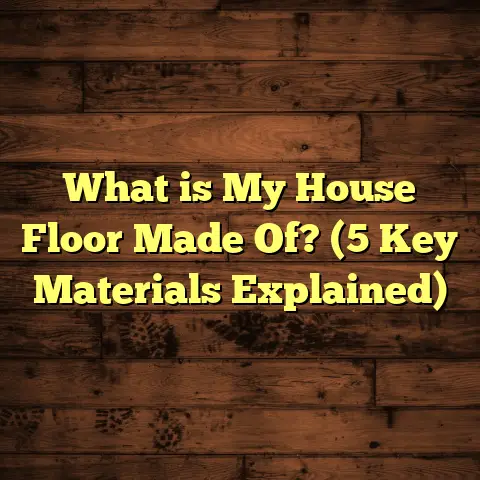What is Floor Prep? (5 Essential Steps for Perfect Flooring)
Have you ever noticed how some floors stay flawless and beautiful for years, while others seem to wear out or get damaged almost immediately after installation? What if I told you that the secret behind a floor’s durability and appearance isn’t just the material you choose but what happens before that material even touches the floor? That’s right—how you prepare the floor underneath plays a massive role in whether your floor looks amazing or becomes a nightmare.
I’m going to walk you through everything I’ve learned over my years as a flooring contractor about floor prep—the step that many people overlook but that makes all the difference. You’ll get the full scoop on what floor prep really means, why it’s so important, and exactly how to do it right to guarantee perfect flooring.
What is Floor Prep?
Let’s start with the basics: what is floor prep? In the simplest terms, floor prep is the process of getting your subfloor or existing surface ready for new flooring installation.
Think of it like this: when you want to build a house, you first need a strong, level foundation. You wouldn’t start stacking bricks on uneven ground or on dirt that’s wet and unstable, right? The same principle applies here. Your flooring material—whether wood, tile, vinyl, laminate, or carpet—needs a clean, level, dry, and secure surface underneath.
Floor prep involves several key activities: cleaning, repairing, leveling, moisture testing, and sometimes installing underlayments or vapor barriers. It’s the groundwork that ensures your new floor will look great and last long.
The Subfloor: The Unsung Hero
Most people don’t even know what a subfloor is until they start remodeling. The subfloor is the structural layer beneath your finished floor. It’s usually made of plywood or concrete.
I can’t tell you how many times I’ve been called out to fix problems caused by ignoring the subfloor condition. A rough or damaged subfloor will transfer those imperfections right up through your new flooring. It doesn’t matter if you spent thousands on exotic hardwood or high-end tiles—if the base isn’t ready, things will go wrong.
My First Wake-Up Call
When I started flooring work years ago, I installed hardwood over a subfloor that hadn’t been properly cleaned or leveled. At first glance, everything looked fine. But within months, the wood started cupping and gaps appeared between planks. I had to rip out and reinstall the floor at no extra charge—a costly lesson.
That experience taught me that floor prep isn’t just another step—it’s the foundation of every successful flooring job.
Why Floor Prep Matters More Than You Think
You may be wondering: is it really that important? Can’t I just lay down my flooring over what’s already there?
Well, according to industry data, improper floor prep accounts for more than 70% of flooring installation failures. That means most issues like bubbling vinyl, cracked tile, warped hardwood, or sagging carpet are caused by skipping or rushing the prep work.
Cost Implications
And these failures are expensive. Fixing a bad flooring install can cost up to three times as much as doing it right the first time.
Here’s a simple breakdown:
| Issue Caused by Poor Prep | Average Repair Cost |
|---|---|
| Vinyl bubbling or peeling | $500 – $1,500 per room |
| Hardwood warping or cupping | $2,000 – $5,000 |
| Tile cracking or loosening | $1,000 – $3,000 |
| Carpet sagging or bubbling | $1,000 – $2,500 |
Avoiding these problems starts by giving proper attention to floor prep.
Real-World Example: Rushing Leads to Disaster
A client once wanted to install laminate flooring over an old plywood subfloor without checking moisture levels or leveling. Within six months, the laminate began buckling and separating along edges. In hindsight, spending an extra day leveling and moisture testing could have prevented this costly issue.
How Long Should Floor Prep Take?
Depending on your project size and condition of existing floors, prep can take anywhere from a few hours to several days. Yes—it sounds like a lot of work upfront. But trust me—proper prep saves time and headaches down the line.
The 5 Essential Steps for Perfect Flooring
Now let’s get into the nitty-gritty. Here are my five essential steps for prepping any floor perfectly.
Step 1: Inspection & Assessment — Know What You’re Dealing With
Before touching any tools or materials, I always thoroughly inspect the existing floor or subfloor. This step is like giving your floor a full health checkup.
What I Look For:
- Surface cleanliness: Dust, dirt, grease?
- Levelness: Are there dips or high spots?
- Moisture levels: Any signs of dampness or water damage?
- Subfloor integrity: Loose boards? Cracks? Holes?
- Previous flooring: Is old flooring fully removed?
No surprises allowed here! If you don’t know what you’re dealing with, you can’t fix it.
Tools I Use for Inspection
- Long level or straight edge for flatness check
- Moisture meter (digital)
- Flashlight to spot hidden damage
- Probe for soft spots in wood
Flatness Standards
According to the World Floor Covering Association (WFCA), your subfloor should not have more than 3/16 inch deviation over 10 feet for most types of flooring like vinyl or hardwood. For tile installations, even stricter flatness is required (usually 1/8 inch over 10 feet).
Personal Experience: Hidden Damage Found
Once during a renovation in an old house built in 1950s, I found serious water damage hidden beneath worn hardwood floors. The owners had no idea their crawl space was leaking. Catching this early allowed us to replace damaged sections and install moisture barriers before anything else.
Step 2: Cleaning — Don’t Skip This Step!
You might be tempted to skip this if the floor looks “clean.” Trust me—don’t do it!
Even tiny dust particles can ruin adhesion and cause lumps that show through your finished flooring.
How I Clean the Subfloor
- Sweep thoroughly with a stiff broom.
- Vacuum using a shop vac to pick up fine dust.
- For concrete floors—sometimes mop with a mild cleaner if grease or stains are present.
- Avoid excessive water on wooden subfloors as it can raise moisture levels.
Why It Matters
Adhesives bond poorly to dusty surfaces. Plus debris underneath can cause bumps or uneven wear.
A Cautionary Tale
I installed vinyl flooring in a commercial kitchen where the subfloor looked clean but was dusty beneath. Within weeks bubbles appeared across the surface due to poor adhesion caused by dust. After re-cleaning and reinstalling properly, the issues disappeared.
Step 3: Leveling & Smoothing — The Game-Changer
Uneven floors are one of the biggest causes of flooring problems like cracks and premature wear.
How I Level Subfloors
- For wooden subfloors, I sand down high spots with a belt sander.
- Low spots get patched with plywood or leveling compound made for wood.
- For concrete slabs, I use self-leveling cement compounds that flow and fill dips.
- After applying leveling material—always check flatness again with a long level.
Research Insight
A study by the National Wood Flooring Association found that floors leveled within guidelines increased hardwood lifespan by nearly 40%. That’s huge!
Case Study: Uneven Concrete Saved by Leveling Compound
On one basement remodel project, the concrete slab was uneven by almost half an inch across one room due to settling over decades. Using self-leveling compound instead of tearing out and replacing saved thousands of dollars in labor and materials.
Step 4: Moisture Testing & Mitigation — Don’t Ignore This Enemy
Moisture is one of the biggest threats to many types of flooring—especially wood floors and laminates.
How I Test Moisture
- Use digital moisture meters designed for concrete and wood.
- For concrete slabs, I sometimes perform calcium chloride tests (a standard test for moisture vapor emission).
- Relative humidity testing inside slab can also be done with in-situ probes when needed.
Moisture Limits for Flooring Types
| Flooring Type | Max Moisture Level (Concrete Subfloor) |
|---|---|
| Hardwood | 3% moisture content |
| Laminate | 2% moisture content |
| Vinyl | Up to 5% moisture content generally |
| Tile (with mortar) | Generally tolerates higher moisture |
Moisture Barriers & Sealants
If moisture levels are too high:
- Apply vapor barriers under flooring.
- Use moisture mitigation sealers on concrete.
- Fix external drainage issues if needed (gutters, grading).
Stats You Should Know
The Concrete Moisture Council reports that moisture-related failures cause nearly 25% of all flooring callbacks nationwide.
Personal Story: Basement Hardwood Saved by Moisture Testing
In one project installing engineered hardwood in a basement, testing revealed elevated moisture due to poor exterior drainage. We fixed drainage and added vapor barriers before installation—avoiding warping and costly callbacks.
Step 5: Repairing & Securing — Fix Issues Before Moving On
Any cracks, holes, loose boards must be fixed before laying down new flooring.
What I Do:
- Nail or screw down loose plywood boards.
- Fill cracks with appropriate fillers (wood filler for wood floors; epoxy for concrete).
- Replace severely damaged plywood sheets.
- Patch holes in concrete with epoxy or patch compounds.
Loose subfloors cause squeaks and unstable floors which ruin finishes quickly.
More Details on Each Step from My Experience
Inspection & Assessment — Don’t Underestimate This!
During inspection, I always ask myself:
- Is this surface stable?
- Are there signs of water damage?
- Will this surface allow adhesives or nails to hold well?
Years back at a large commercial jobsite with tile installation scheduled, we found an entire section of plywood subfloor was soft due to rot caused by a leaking pipe below. Replacing those sheets took time but prevented tile cracks down the road.
Cleaning — Nuts & Bolts of a Dust-Free Surface
You might think vacuuming once is enough but dust settles fast! I often vacuum twice using different angles to remove all fine debris.
For greasy surfaces like kitchens or garages—using degreasing agents safe for subfloors helps adhesives stick properly.
Leveling — When Flatness Isn’t Flat Enough
I carry a long straightedge (usually 6 to 10 feet) onsite to check flatness repeatedly throughout leveling work.
Sometimes after applying leveling compound on concrete slabs I wait overnight then re-check flatness before moving forward.
If you skip this step for tile especially—you’ll see grout lines crack as tile flexes on uneven ground.
Moisture Testing — A Step Many Ignore But Regret Later
I always recommend buying or renting a quality digital moisture meter for homeowners trying DIY projects. It pays off in peace of mind before expensive installs.
If you find elevated moisture levels:
- Investigate external water sources.
- Add vapor barriers or sealers.
- Consider alternative flooring options more tolerant of moisture (like vinyl).
Repair & Securing — The Finishing Touch Before Installation
Loose plywood causes squeaking sounds when walking—one of the most common complaints after install.
Filling cracks makes sure your floor stays strong and smooth under pressure from foot traffic and furniture weight.
Common Questions About Floor Prep
How Long Does Floor Prep Usually Take?
It depends heavily on existing conditions:
- New construction with clean subfloor: few hours.
- Remodel with old layers removal + repairs: days.
Rushing leads to callbacks and failures so take your time!
Can I Install Flooring Directly Over Concrete?
Yes—but only if it’s clean, level, dry, and free from cracks. Moisture testing is critical here.
What Happens If I Skip Floor Prep?
You risk adhesive failure, warping floors, uneven wear patterns, squeaking floors, bubbling vinyl—all costly problems later on.
Flooring Types & Their Specific Prep Needs
Different materials require slightly different prep methods:
| Flooring Type | Key Prep Considerations |
|---|---|
| Hardwood | Levelness within 3/16 inch over 10 ft; dry wood substrate; smooth surface |
| Laminate | Moisture-free; flat surface; clean |
| Vinyl | Flatness critical; clean surface; sometimes underlayment needed |
| Tile | Very flat surface critical; cracks repaired; moisture tested |
| Carpet | Patching holes; leveling minor dips; clean |
Extra Tips From My Toolbox
Here are some insider tips I’ve picked up:
- Always use manufacturer-recommended primers or adhesives after cleaning.
- Protect floors during prep with rosin paper to avoid damage.
- When using self-leveling compounds—mix carefully per instructions; too watery weakens strength.
- For repairs—match filler materials to subfloor type for best bonding.
Real-Life Case Studies From My Projects
Case Study #1: Basement Turnaround
A client wanted engineered hardwood in their damp basement. Initial moisture tests showed levels above recommended limits. We fixed external drainage issues around house foundation then installed vapor barrier and applied moisture sealer on slab prior to wood installation. Result? Beautiful floor with no warping after two years despite occasional flooding outside.
Case Study #2: Kitchen Tile Disaster Averted
During kitchen remodel in an old home with uneven plywood subfloor (warped from years of water spills), we removed damaged boards and applied self-leveling compound before tile installation. Tile grout lines remained intact after one year despite heavy use—a success story showing how leveling matters.
Case Study #3: Commercial Vinyl Failure Fixed
In a restaurant install where vinyl bubbled after two months due to dusty concrete slab not cleaned properly prior to install—we completely redid cleaning process including degreasing mop step before reinstalling vinyl successfully.
Wrapping Up: What You Should Take Away
Proper floor prep isn’t glamorous work but it’s absolutely essential if you want your floors to look great and last long. Every time I skip or shortcut prep steps—even if just slightly—I see issues arise later on jobsites.
If you’re planning any kind of flooring project (DIY or hiring pros), remember these key points:
- Inspect carefully before starting.
- Clean thoroughly—dust kills adhesion.
- Level surfaces precisely.
- Always test moisture levels and mitigate if needed.
- Repair all damage before laying down finish flooring.
A little effort upfront pays off big time in durability and appearance—and saves you money fixing problems later.
Got questions about your specific project? Feel free to ask! I’ve seen it all and love sharing what works best from real-world experience.





